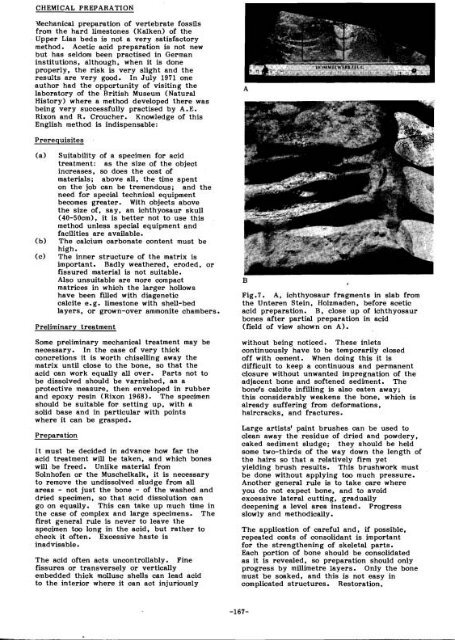Number 3 - Geological Curators Group
Number 3 - Geological Curators Group
Number 3 - Geological Curators Group
You also want an ePaper? Increase the reach of your titles
YUMPU automatically turns print PDFs into web optimized ePapers that Google loves.
CHEMICAL PREPARATIONMechanical preparation of vertebrate fossilsfrom the hard limestones (Kalken) of theUpper Lias beds is not a very satisfactorymethod. Acetic acid preparation is not newbut has seldom been practised in Germaninstitutions, although, when it is doneproperly, the risk is very slight and theresults are very good. In July 1971 oneauthor had the opportunity of visiting thelaboratory of the British Museum (NaturalHistory) where a method developed there wasbeing very successfully practised by A. E.Rixon and R. Croucher. Knowledge of thisEnglish method is indispensable:Prerequisites(a)(b)(C)Suitability of a specimen for acidtreatment: as the size of the objectincreases, so does the cost ofmaterials; above all, the time spenton the job can be tremendous; and theneed for special technical equipmentbecomes greater. With objects abovethe size of, say, an ichthyosaur skull(40-50cm). it is better not to use thismethod unless special equipment andfacilities are available.The calcium carbonate content must behigh.The inner structure of the matrix isimportant. Badly weathered, eroded, orfissured material is not suitable.Also unsuitable are more compactmatrices in which the larger hollowshave been filled with diageneticcalcite e. g. limestone with shell-bedlayers, or grown-over ammonite chambers.Preliminary treatmentSome preliminary mechanical treatment may benecessary. In the case of very thickconcretions it is worth chiselling away thematrix until close to the bone, so that theacid can work equally all over. Parts not tobe dissolved should be varnished, as aprotective measure, then enveloped in rubberand epoxy resin (Rixon 1968). The specimenshould be suitable for setting up, with asolid base and in particular with pointswhere it can be grasped.PreparationIt must be decided in advance how far theacid treatment will be taken, and which boneswill be freed. Unlike material fromSolnhofen or the Muschelkalk, it is necessaryto remove the undissolved sludge from allareas - not just the bone - of the washed anddried specimen, so that acid dissolution cango on equally. This can take up much time inthe case of complex and large specimens. Thefirst general rule is never to leave thespecimen too long in the acid, but rather tocheck it often. Excessive haste isinadvisable.The acid often acts uncontrollably. Finefissures or transversely or verticallyembedded thick mollusc shells can lead acidto the interior where it can act injuriouslyFig.7. A, ichthyosaur fragments in slab fromthe Unteren Stein, Holzmaden, before aceticacid preparation. B, close up of ichthyosaurbones after partial preparation in acid(field of view shown on A).without being noticed. These inletscontinuously have to be temporarily closedoff with cement. When doing this it isdifficult to keep a continuous and permanentclosure without unwanted impregnation of theadjacent bone and softened sediment. Thebone's calcite infilling is also eaten away;this considerably weakens the bone, which isalready suffering from deformations,haircracks, and fractures.Large artists' paint brushes can be used toclean away the residue of dried and powdery,caked sediment sludge; they should be heldsome two-thirds of the way down the length ofthe hairs so that a relatively firm yetyielding brush results. This brushwork mustbe done without applying too much pressure.Another general rule is to take care whereyou do not expect bone, and to avoidexcessive lateral cutting, graduallydeepening a level area instead. Progressslowly and methodically.The application of careful and, if possible.repeated coats of consolidant is importantfor the strengthening of skeletal parts.Each portion of bone should be consolidatedas it is revealed, so preparation should onlyprogress by millimetre layers. Only the bonemust be soaked, and this is not easy incomplicated structures. Restoration,
















